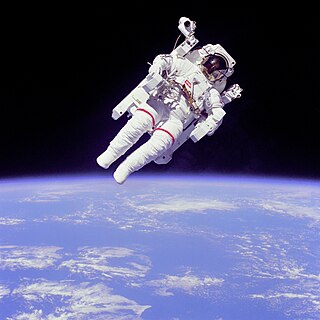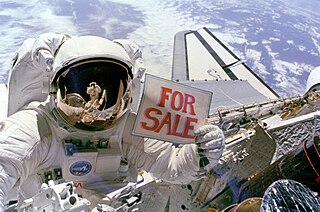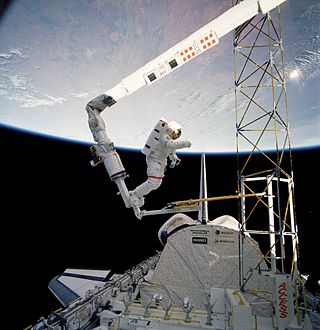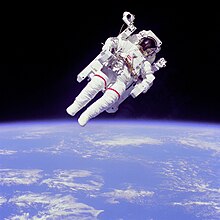Weightless maneuvering
In 1961, three years before a US astronaut walked in space, USAF Officer Whitsett imagined how astronauts could "fly" in space without tethers while working at the Air Force Institute of Technology (AFIT) at Wright-Patterson Air Force Base, Ohio. [5] In 1962, he studied the human body's response to weightlessness. He developed the mathematical model for human mass distribution, center of mass, moments of inertia, and body movement. Whitsett used a Reduced-gravity aircraft to validate his model, but the test were inconclusive. [6] [7] He started work at NASA in 1966 while on assignment from the USAF as the experiment coordinator for the manned spaceflight program. [4] In 1968, astronaut McCandless joined Whitsett's office to work on a "Buck Rodgers style backpack." [8] Whitsett then worked for the Apollo Applications Program (AAP), Project Apollo, and Skylab. Project Apollo Missions had 170 hours of extravehicular, Whitsett developed movement devices for the lunar surface environment, including a hand-held, self-propulsion gun. [3]
In 1971 he designed a nitrogen gas powered device called the M509. [5] Maj. Charles E. Whitsett, USAF worked in the STS Group, Space Shuttle Program Office, NASA's Johnson Space Center (JSC). [9] In 1973, Major Whitsett headed the M509 experimental program while assigned to the Manned Spacecraft Center and the Air Force Space and Missile Systems Organization (SAMSO). His control of development objectives, costs, and his ability to consolidate research between USAF and NASA was noted by administrators. Whitsett highlighted the backpack program: "An experimental MMU tested onboard the NASA Skylab Program orbital workshop established key piloting characteristics and capability base for future MMU systems" and yielded the operational MMU used on the Shuttle missions. [3] Dr. Charles E. Whitsett, Jr. and Astronaut McCandless were the principal investigators for Skylab's experiment M509 in 1973-74. [5] [10] M509 demonstrated astronaut maneuvering unit (AMU) flying qualities for future AMU design requirements and projected EVA capabilities. The entire EVA system included two jet-powered AMUs, an automatically stabilized maneuvering unit (ASMU), and a handheld maneuvering unit (HHMU). The ASMU was powered by a high-pressure nitrogen propellant tank and battery. Pilot directed jets supplemented a control gyro and reaction stabilization jets. The ASMU provided propellant and instrumentation for evaluation of the HHMU mode. The ASMU used 14 fired thrusters located in various positions on the backpack. Arms extending from the backpack had thruster controls. Flying the units inside Skylab, three crew members flew four experiment flights. They tested operations procedures and analyzed flight qualities reporting on progress to mission control. [11] Flying the AMU, the right hand controls roll about all three axis and the left hand controls movement forward, back, left, and right. The gyro with a computer enables hands free, station keeping operations. [5]
Upon his USAF retirement in 1977, he was hired by NASA. [5] Whitsett spent over 100 hours flying the MMU's prime contractor simulator at Martin Marietta in Denver. [12]

Extravehicular activity (EVA) is any activity done by an astronaut in outer space outside a spacecraft. In the absence of a breathable Earthlike atmosphere, the astronaut is completely reliant on a space suit for environmental support. EVA includes spacewalks and lunar or planetary surface exploration. In a stand-up EVA (SEVA), an astronaut stands through an open hatch but does not fully leave the spacecraft. EVA has been conducted by the Soviet Union/Russia, the United States, Canada, the European Space Agency and China.

STS-6 was the sixth NASA Space Shuttle mission and the maiden flight of the Space ShuttleChallenger. Launched from Kennedy Space Center on April 4, 1983, the mission deployed the first Tracking and Data Relay Satellite, TDRS-1, into orbit, before landing at Edwards Air Force Base on April 9, 1983. STS-6 was the first Space Shuttle mission during which a spacewalk was conducted, and hence was the first in which the Extravehicular Mobility Unit (EMU) was used.

The Manned Maneuvering Unit (MMU) is an astronaut propulsion unit that was used by NASA on three Space Shuttle missions in 1984. The MMU allowed the astronauts to perform untethered extravehicular spacewalks at a distance from the shuttle. The MMU was used in practice to retrieve a pair of faulty communications satellites, Westar VI and Palapa B2. Following the third mission the unit was retired from use. A smaller successor, the Simplified Aid For EVA Rescue (SAFER), was first flown in 1994, and is intended for emergency use only.

STS-41-C was NASA's eleventh Space Shuttle mission, and the fifth mission of Space Shuttle Challenger. The launch, which took place on April 6, 1984, marked the first direct ascent trajectory for a Space Shuttle mission. During the mission, Challenger's crew captured and repaired the malfunctioning Solar Maximum Mission satellite, and deployed the Long Duration Exposure Facility (LDEF) experimental apparatus. STS-41-C was extended one day due to problems capturing the Solar Max satellite, and the landing on April 13, 1984, took place at Edwards Air Force Base, instead of at Kennedy Space Center as had been planned. The flight was originally numbered STS-13.

Robert Laurel Crippen is an American retired naval officer and aviator, test pilot, aerospace engineer, and retired astronaut. He traveled into space four times: as pilot of STS-1 in April 1981, the first Space Shuttle mission; and as commander of STS-7 in June 1983, STS-41-C in April 1984, and STS-41-G in October 1984. He was also a part of the Manned Orbiting Laboratory (MOL), Skylab Medical Experiment Altitude Test (SMEAT), ASTP support crew member, and the Approach and Landing Tests (ALT) for the Space Shuttle.

STS-41-B was the tenth NASA Space Shuttle mission and the fourth flight of the Space ShuttleChallenger. It launched on 3 February 1984, and landed on 11 February 1984 after deploying two communications satellites. It was also notable for including the first untethered spacewalk.

STS-51-A was the 14th flight of NASA's Space Shuttle program, and the second flight of Space Shuttle Discovery. The mission launched from Kennedy Space Center on November 8, 1984, and landed just under eight days later on November 16, 1984.

STS-61-B was NASA's 23rd Space Shuttle mission, and its second using Space Shuttle Atlantis. The shuttle was launched from Kennedy Space Center, Florida, on November 26, 1985. During STS-61-B, the shuttle crew deployed three communications satellites, and tested techniques of constructing structures in orbit. Atlantis landed at Edwards Air Force Base, California, at 16:33:49 EST on December 3, 1985, after 6 days, 21 hours, 4 minutes, and 49 seconds in orbit.

Dale Allan Gardner was a NASA astronaut, and naval flight officer who flew two Space Shuttle missions during the mid 1980s.

Karol Joseph "Bo" Bobko, , is an American aerospace engineer, retired U.S. Air Force officer, test pilot, and a former USAF and NASA astronaut. Bobko was the first graduate of the US Air Force Academy to travel in space.

Bruce McCandless II was a United States Navy officer and aviator, electrical engineer, and NASA astronaut. In 1984, during the first of his two Space Shuttle missions, he completed the first untethered spacewalk by using the Manned Maneuvering Unit.

Robert Lee Stewart is a retired brigadier general of the United States Army and a former NASA astronaut.

The Extravehicular Mobility Unit (EMU) is an independent anthropomorphic spacesuit that provides environmental protection, mobility, life support, and communications for astronauts performing extravehicular activity (EVA) in Earth orbit. Introduced in 1981, it is a two-piece semi-rigid suit, and is currently one of two types of EVA spacesuits used by crew members on the International Space Station (ISS), the other being the Russian Orlan space suit. It was used by NASA's Space Shuttle astronauts prior to the end of the Shuttle program in 2011.

Simplified Aid For EVA Rescue (SAFER) is a small, self-contained, propulsive backpack system worn during spacewalks, to be used in case of emergency only. If an untethered astronaut were to lose physical contact with the vessel, it would provide free-flying mobility to return to it. It is worn on spacewalks outside the International Space Station (ISS), and was worn on spacewalks outside the Space Shuttle. So far, there has not been an emergency in which it was needed. SAFER is a small, simplified version of the Manned Maneuvering Unit (MMU), which was used for regular maneuvering.

William Frederick Fisher is an American physician and a former NASA astronaut. Fisher went into space in 1985 on board the Space Shuttle. He retired from NASA in 1992 and returned to the full-time practice of medicine. His time at NASA coincided with that of his former wife and fellow astronaut Anna Lee Fisher. He is also the great grandson of Pony Express rider William Frederick Fisher

The Hand-Held Maneuvering Unit (HHMU), also known as the maneuvering gun, or informally as "the zip gun", was first astronaut propulsion unit. It was first used by astronaut Ed White during the first American "spacewalk", on Gemini 4, June 3, 1965. Different models of HHMU were present on Gemini 4, 8, 10, and 11, but were only used on Gemini 4 and 10. It was also used aboard Skylab.

NASA Astronaut Group 7 was a group of seven astronauts accepted by the National Aeronautics and Space Administration (NASA) on August 14, 1969. It was the last group to be selected during the Project Apollo era, and the first since the Mercury Seven in which all members were active-duty military personnel, and all made flights into space.

An astronaut propulsion unit is used to move an astronaut relative to the spaceship during a spacewalk. The first astronaut propulsion unit was the Hand-Held Maneuvering Unit (HHMU) used on Gemini 4.

















